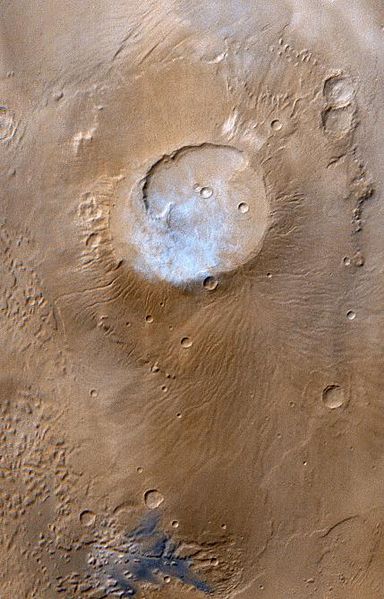File:Apollinaris Patera (PIA02006).jpg
Apollinaris_Patera_(PIA02006).jpg (384 × 599 pixels, file size: 55 KB, MIME type: image/jpeg)
Summary
This month (April 1999), the Mars Global Surveyor Mars Orbiter Camera (MOC) passed over the Apollinaris Patera volcano and captured a patch of bright clouds hanging over its summit in the early martian afternoon. This ancient volcano is located near the equator and--based on observations from the 1970s Viking Orbiters--is thought to be as much as 5 kilometers (3 miles) high. The caldera--the semi-circular crater at the volcano summit--is about 80 kilometers (50 miles) across.
The color in this picture was derived from the MOC red and blue wide angle camera systems and does not represent true color as it would appear to the human eye (that is, if a human were in a position to be orbiting around the red planet). Illumination is from the upper left.
Malin Space Science Systems and the California Institute of Technology built the MOC using spare hardware from the Mars Observer mission. MSSS operates the camera from its facilities in San Diego, CA. The Jet Propulsion Laboratory's Mars Surveyor Operations Project operates the Mars Global Surveyor spacecraft with its industrial partner, Lockheed Martin Astronautics, from facilities in Pasadena, CA and Denver, CO.
Source http://photojournal.jpl.nasa.gov/catalog/PIA02006 Author NASA/JPL/MSSS
Licensing
Public domain images are available for anybody to use without any licenses, royalties, or special permissions.
File history
Click on a date/time to view the file as it appeared at that time.
| Date/Time | Thumbnail | Dimensions | User | Comment | |
|---|---|---|---|---|---|
| current | 16:04, 25 January 2019 |  | 384 × 599 (55 KB) | Suitupandshowup (talk | contribs) | This month (April 1999), the Mars Global Surveyor Mars Orbiter Camera (MOC) passed over the Apollinaris Patera volcano and captured a patch of bright clouds hanging over its summit in the early martian afternoon. This ancient volcano is located near th... |
You cannot overwrite this file.
File usage
The following page uses this file:







